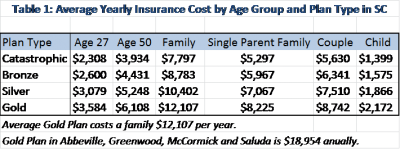Obamacare Packs a Punch For Young and Rural South Carolinians

Editor
Imagine for a minute that 5 years ago, your 90 year-old grandmother chose a very simple cell phone that has four huge buttons, each capable dialing a single number: her two children, her physician and 911. Her monthly bill is $14.95 including taxes and fees.
Imagine then that a government agency comes along, declares her phone and plan “substandard” and replaces her no-frills phone with a Samsung Galaxy smart phone and a fee of $149 per month.
Now Grandma has a phone she can’t really use full of features she doesn’t really need at a cost she can barely afford on her fixed income. Would you stand for that? Of course not.
But that is exactly what has happened with health insurance under Obamacare…and not just for Grandma.
The health plans we were told we “could keep” are no longer available…and the plans replacing them are expensive and full of features we don’t want or need. In fact, our research shows that young South Carolinians and those living in rural areas are getting hit the hardest.
BY THE NUMBERS
In the last quarter of 2013, the United States Department of Health and Human Services (HHS) released its listing of healthcare plans available through Affordable Care Act (ACA) exchanges, along with premiums for each plan. Because South Carolina chose not to create its own exchange, the costs are for plans offered on a federally-administered exchange operating in the state and the 33 other states that do not run their own programs.[i]
The five categories—Catastrophic, Bronze, Silver, Gold and Platinum—reflect the level of benefits and the percentage of costs the policyholder will pay. Under the Catastrophic and Bronze plans, subscribers will pay 40% of the cost, Silver plan holders will pay 30% and Gold 20%. The out of pocket cost for the Platinum plan would be 10%, but no Platinum plans are offered in South Carolina as a part of an exchange. Four companies are offering plans in various parts of the state: Blue Choice Health Plan, BlueCross BlueShield of South Carolina, Consumers’ Choice Health Plan and Coventry One. (Coventry One is offering plans in only 13 of the state’s 46 counties.)
So, what is the bottom line?
The price for Obamacare is steep in South Carolina and hard on the rural and the young especially. Statewide, the average price for the Gold plan is $12,107 per family per year. That ranks South Carolina at #19 among the 50 states. The Catastrophic Plan, designed for only major medical events, is nearly $8,000 per year per family, which is the 8th most expensive rate in the country.
ACA is particularly hard on rural counties. According to Palmetto Policy Forum’s analysis of rural versus urban counties (Table 2), rural counties pay significantly more in premiums. This is common across the country. Tom Hirsig, Wyoming’s Insurance Commissioner characterized it this way: “I think the problem was that the Affordable Care Act was designed for where the majority of the people live, in the big cities where there’s a lot of competition among health care providers.”[ii]
One also wonders what happened in the Upper Savannah region, where rates are also significantly higher. For one Gold Plan, Abbeville, Greenwood, McCormick and Saluda Gold Plans cost a family $18,954 annually. That’s nearly $7,000 per year more than the state average. Chester and Lancaster also suffer from abnormally high rates.
As for the young, they are getting hit hard as well…if they sign up. Reports coming out of California, Kentucky, Connecticut and Michigan, leading to what health experts term “adverse selection” where rates continue to climb.[iii] The average age is high and younger Americans aren’t signing up like the 55-64 year old group. This is alarming for ACA supporters, which was based on a Ponzi-scheme financial model that required everyone to buy insurance so that the younger and healthier would subsidize the older and sicker. But young people just aren’t taking the bait.
So while technical issues with the Obamacare website are being fixed, the far greater underlying problems with the bill itself persist and will continue to deliver increasing pain to rural and young South Carolina.
[i] U.S. Centers for Medicare and Medicaid Services, Data.Healthcare.gov: QHP Individual Medical Landscape.
[ii] Reed Abelson, Katie Thomas, and Jo Craven McGinty, “Health Care Law Fails to Lower Prices for Rural Areas,” The New York Times, October 23, 2013.
[iii] Sally Pipes, “It’s not just Healthcare.gov: Obamacare Has a Serious Age Discrimination Problem,” Forbes, December 9, 2013.








